Garmin Watch for Surfing: Features and Insights
Intro
As the sun rises over the ocean, surf enthusiasts gear up for another day riding the waves. While the thrill of catching the perfect swell is timeless, technology has begun to play an essential role in enhancing the surfing experience. Enter the Garmin watch—designed specifically for surfers and outdoor adventurers alike. This device doesn't just tell time; it offers a suite of tools that can track performance, provide weather updates, and help everyone from beginners to advanced surfers monitor their sessions with unprecedented detail.
Techniques and Skills
Fundamental Techniques for Beginners
When stepping onto the surfboard for the first time, it’s crucial to grasp the basics. Many novice surfers struggle with balance and positioning. The Garmin watch comes to the rescue by measuring the heart rate and calories burned, which can motivate beginners to improve their stamina and technique. In addition to tracking physical metrics, surfers can also record their sessions, allowing for analysis of progress over time.
Consider the following key points:
- Finding Your Stance: Beginners need to figure out whether they are regular or goofy-footed. This affects foot placement and turns.
- Paddling Technique: Properly paddling out involves using strong, even strokes; the watch can help track time spent paddling.
- Timing the Waves: Learning to read the ocean is critical. The Garmin watch assists by noting wave data, enhancing understanding of when to catch them.
Advanced Skills for Experienced Athletes
For seasoned surfers, the pursuit of excellence never stops. Advanced surfers can leverage the Garmin watch's capabilities for fine-tuning performance metrics. It tracks speed, distance traveled, and surf-specific metrics like wave counts. This data allows for critical analysis, which can pinpoint strengths and weaknesses during sessions.
Top skills to refine include:
- Dynamic Maneuvers: Play with turns, cutbacks, and aerials, utilizing feedback from the watch to see how speed and trajectory affect performance.
- Wave Selection: Experienced surfers can study data collected during past sessions to better predict which waves to ride next.
- Surf Forecasting: Advanced users can program the watch to notify them about optimal surf conditions based on weather and tide data.
Safety and Gear
Essential Safety Measures in Watersports
When enjoying watersports such as surfing, safety must always come first. The Garmin watch promotes conscious surfing through features designed to keep users informed and secure. Alerts about weather changes and tide updates are crucial in ensuring surfers are aware of their surroundings. Additionally, setting up emergency contacts is a wise move—help can be just a click away if needed.
Gear Reviews and Recommendations
Not all gear is created equal. When it comes to surfing, having the right equipment can make or break the experience. Reviews inform about gear durability and performance under specific conditions. The following items are worth taking into account:
- Wetsuits: A good wetsuit keeps surfers warm and buoyant. Brands like Rip Curl and O'Neill have highly rated options suitable for various water temperatures.
- Surfboards: Depending on skill level, board types vary from longboards to shortboards. It's important to select the one that suits individual style and waves.
- Surf Leashes: A solid leash is a must for safety. Look for durable materials that provide a secure connection to your board.
The Garmin watch integrates seamlessly with considerable gear that enhances the surfing experience while offering fun insights to improve. Plus, it’s waterproof, making it ideal for out in the ocean. Its potential to become an indispensable tool in any surfer's arsenal cannot be overstated.
Prologue to Garmin Watches
In today's fast-paced world, staying connected and informed while engaging in outdoor activities is paramount, and this is where Garmin shines. The significance of Garmin watches in the realm of watersports, particularly surfing, lies in their ability to integrate advanced tracking features and real-time data—a necessity for those riding the waves.
Historical Overview of Garmin
Garmin, founded in 1989, initially carved its niche in the global positioning systems (GPS) market. Over the years, the brand has evolved remarkably, branching out into various fields, including fitness and marine solutions. Their legacy traces back to aviation navigation devices, gradually transitioning toward consumer electronics that not only guide you on the road but also in the sea. Their rugged and user-friendly approach has transformed the way outdoor enthusiasts interact with technology. With every new model, from early handheld GPS to the latest smartwatches, Garmin has solidified its status as a game changer. The introduction of wearable technology into the surfing domain demonstrates their commitment to enhancing the user experience, making it not just about tracking, but optimizing one’s performance.
The Evolution of Wearables in Watersports
As technology advances, so too do the tools available to water adventurers. The shift from traditional surfing compasses to integrated smartwatches is nothing short of revolutionary. Wearables, particularly those made by Garmin, have changed the landscape of watersports training and enjoyment.
Initially, surfers relied on basic tools like board shorts with pockets to hold simple devices or even tied strings for timing their rides. However, the emergence of waterproof smartwatches has pushed the envelope, allowing surfers to access critical data such as wave frequency and tidal adjustments right from their wrist while they’re in the ocean.
"The watch isn't just a fancy accessory; it's a vital part of our surf kit. We can read the ocean like we used to read the sky."
This evolution signifies a tremendous leap not only in functionality but also in convenience. For surfers, wearing a Garmin watch has become synonymous with maximizing their time on the water, helping them catch the best waves by offering detailed analytics on their performance.
As we dive deeper into Garmin’s offerings tailored for surfers, understanding its history and the evolution of wearable tech helps to grasp how these devices have become indispensable tools for both novice and seasoned surfers.
Key Features of the Garmin Watch for Surfing
In the ever-evolving world of surfing, having the right kind of gear can make or break your experience, and this is where the Garmin watch comes into play. Not only does it contribute to tracking your performance, but it also helps in planning your surf sessions like a pro. The features packed into these devices underscore their relevance for serious surfers. Whether you’re aiming for a casual ride or looking to nail that new trick, the Garmin watch is designed to enhance your experience in the water.
Activity Tracking Capabilities
The heart of the Garmin watch's success lies in its impressive activity tracking capabilities. Each surfer is unique, and their surfing styles vary. Therefore, having a tool that reflects the nuances of one’s surfing style is vital. The following include three noteworthy features that promise an enriched understanding of your surfing sessions:
GPS Tracking
One of the standout aspects of GPS tracking on the Garmin watch is its ability to map your surfing journey. Each session can be meticulously tracked, showing not just your location, but also your routes. This is pivotal for understanding how your skills evolve over time. For example, when you surf in familiar waters, it allows you to see if you're going the same route or branching out into new waves.
A key characteristic is the accuracy of the GPS system. Many users rave about its reliability, making it a go-to choice for both seasoned surfers and newcomers alike. The unique feature here is its real-time tracking, allowing surfers to pinpoint every wave they ride. But if there’s a downside, it might be that prolonged use can drain battery life quicker than expected, prompting surfers to plan carefully.
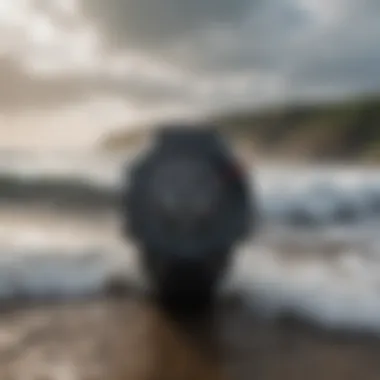
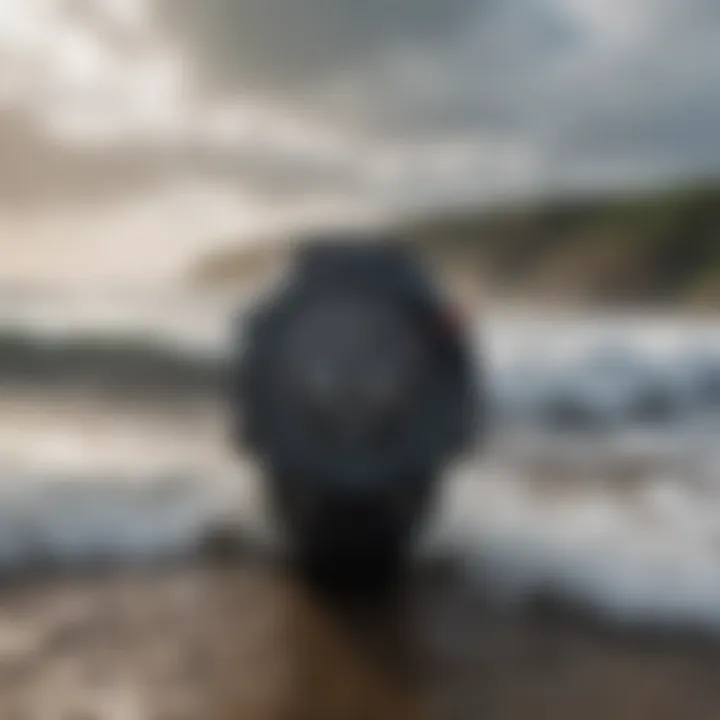
Waves Count
Another essential feature is the waves count. This function is crucial in keeping track of how many waves you catch during your sessions. Surfers can sometimes lose count while focusing on the next big swell, and having a real-time counter helps to keep those stats accurate.
The key highlight of waves count is its ability to provide data that can be analyzed later. It’s often used by competitive surfers to measure performance and work on tactics. The unique aspect is how it encourages surfers to push their limits. The challenge, however, lies in maintaining the accuracy of the data in crowded waters where waves can overlap and be hard to distinguish.
Distance Surged
Measuring the distance surged can be game-changing for surfers wanting to enhance their efficiency on the water. This metric helps to acknowledge how far you’ve paddled in pursuit of those perfect waves.
The unique feature of distance surged offers something more than just numbers; it gives insights into your stamina and endurance levels. Understanding how much you're exerting yourself is key to improving over time. Although not overly complex, the challenge often arises in interpreting data post-session — some might find it overwhelming to filter out the critical insights from the tallies.
Weather Updates and Alerts
Weather can be as unpredictable as waves can be, so being prepared is half the battle for surfers. The Garmin watch provides excellent weather-related features that help surfers know what to expect before they hit the waves.
Tide Information
For many surfers, tide information is fundamental. Surf conditions fluctuate significantly with the tides, making this data invaluable. The Garmin watch can provide real-time updates, ensuring that surfers are informed about the best times to hit the water.
A key characteristic is its predictive capability. Surfers can plan their sessions around peak conditions, enhancing the quality of their rides. The unique aspect of this is the level of specificity — not only does it present current conditions, but it often includes future forecasts. However, if there’s a drawback, it's that local nuances can sometimes mean conditions deviate from what’s predicted.
Wind Speed Forecasts
Wind speed forecasts come in handy as they influence wave quality. A solid understanding can make the difference between a smooth surf or choppy chaos. The Garmin watch assists by providing accurate data so surfers can find the most enjoyable conditions.
This feature not only informs users but also satisfies those who love digging into stats. Surfers can compare ideal wind conditions against their performance over time. The primary challenge is that strong winds can come up quickly, so relying solely on forecasts might not always play out favorably when you're already in the water.
Wave Height Predictions
Knowing the anticipated wave height can literally set the tone for your surf day. The Garmin watch gives users insights into expected surf heights, helping surfers decide which boards to use and ensuring they're prepared for what's coming.
The key characteristic here is reliability, often leveraging data from nearby buoy readings. The advantage is that it empowers surfers to strategize and maximize their session. Still, one must bear in mind that nature is unpredictable; wave heights can shift even with accurate predictions provided, catching surfers off-guard at times.
Performance Metrics
For surfers keen on honing their skills, gathering actionable insights about performance is essential. Enter the performance metrics offered by the Garmin watch.
Heart Rate Monitoring
Maintaining an optimal heart rate during intensive sessions can be pivotal. The heart rate monitoring feature on the Garmin watch provides surfers crucial insights into their physical exertion levels while out in the surf.
Its high accuracy and real-time feedback can be pivotal, helping users understand when to take a breather. The unique aspect here is the ability to set heart rate zones, making it useful for interval training. A minor drawback might be sensitivity; sometimes, the readings can fluctuate based on water conditions and body placement, leaving users somewhat perplexed.
VO2 Max Estimation
VO2 Max estimation gives surfers a glimpse into their aerobic fitness — how efficiently they are using oxygen during activity. This can be particularly beneficial for those wanting to improve their endurance.
A key characteristic is its ability to use heart rate measurements to derive these estimations, providing insights that are relatively easy to grasp. The unique feature is how it empowers surfers to track improvements over time, setting personal bests. The downside could be that it may take several sessions for an accurate estimate to stabilize, leading some to question its reliability early on.
Recovery Time Assessment
Post-session recovery is as vital as the surfing itself. The recovery time assessment feature aids surfers in understanding how long they need to bounce back after a rigorous surfing session.
Not only does it track your workout intensity, but it also considers various factors to suggest optimal recovery dates. This assessment helps ensure surfers do not push their bodies too far. However, a potential shortfall could be the subjective nature of recovery — everyone’s body responds differently, which might complicate one-size-fits-all suggestions.
Through understanding all these features, surfers can gauge their performance effectively and make adjustments wherever necessary. Gathering insights from their sessions goes a long way in enhancing their skills and preparing for future challenges.
User Experience and Feedback
User experience and feedback are crucial when it comes to the Garmin watch for surfing. It's not just about the tech specs or how good the watch looks on your wrist; what really matters is how those features translate into real-world surfing experiences. Surfers are a picky bunch. They want gear that can hold up against the harshest elements while offering insights that can genuinely improve their time in the water. A watch that misses the mark, say, on tide tracking or GPS accuracy, likely won't earn a second glance. Therefore, examining user experiences lends invaluable insight into the watch's practicality and reliability.
One significant aspect of user experience is how intuitive the interface is. Surfers often find themselves battling against the waves rather than struggling with complicated tech. The device needs to be straightforward and responsive, which is where feedback comes into play. Regular updates to the software based on user comments can enhance usability, making it easier to access crucial data while on the go. Moreover, community opinion often sways purchasing decisions. If avid surfers rave about a feature, it automatically increases a new buyer's interest and confidence in the product.
Surfer Testimonials
When you hear from the surf community, you hear real stories that can paint a vivid picture of the Garmin watch’s capabilities. For example, Tom, a surf enthusiast from California, shared how the watch's wave counting feature transformed his approach to surfing.
"I was skeptical at first, but tracking the waves made me more committed to improving my skills. I could see my progress over time and knew exactly where my strengths lay."
This resonates with many surfers, who crave tangible metrics that can guide their practice and validate their efforts. Others, like Michelle from Hawaii, appreciate its responsiveness in unpredictable environments. She mentioned, "The weather alerts helped me catch that perfect swell before it rolled in, saving me a long drive for nothing."
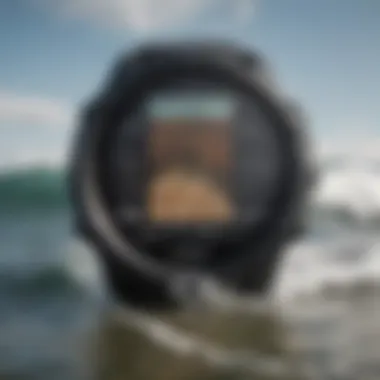
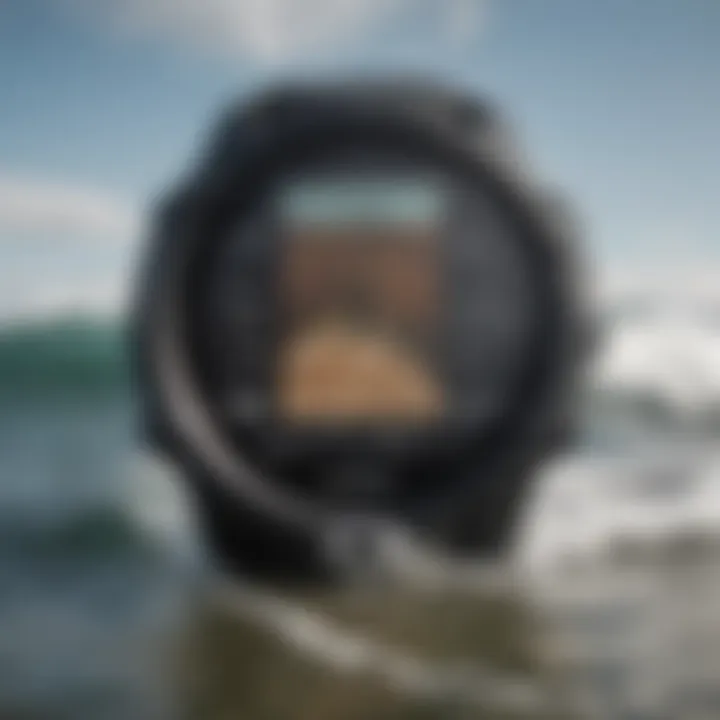
These testimonials highlight various benefits of the Garmin watch: from enhanced performance feedback to critical weather updates. Hearing firsthand experiences from fellow surfers adds a layer of credibility that technical data alone often can't provide. It’s the little things, like one-touch access to tide info, that can switch their mood from frustrated to flow state.
Comparative User Ratings
User ratings give a sense of how the Garmin watch stacks up against its competitors. When you consider stars and reviews, you don't just get numbers; you get a wide array of insights into performance and reliability.
On platforms like Reddit and Facebook, comparisons often zoom in on specific features: battery life, accuracy of the GPS, and overall comfort while surfing. Generally, the Garmin watch garners strong reviews across the board. Users often note that the battery can last through several surf sessions, which speaks volumes about its reliability. For instance, on a scale of one to five, many users give its weather forecasting a solid four or even five stars. On the downside, some users mention a slight learning curve when first starting out, but they often observe that it pays off in the long run.
- Pros:
- Cons:
- Excellent battery life
- Real-time weather updates
- Comprehensive performance tracking
- Initial setup can be tricky
- Not as customizable compared to some competitors
Comparative Analysis with Other Surf Watches
When it comes to choosing a surf watch, the abundant options available can make minds spin, much like the waves themselves. A thorough comparative analysis helps identify what sets the Garmin watch apart from its competitors. In this section, we will evaluate essential elements such as tracking capabilities, interface usability, battery life, and overall value for money. This understanding aids surfers in selecting the right device that suits their unique style and preferences.
Garmin vs. Apple Watch
The first comparison to make is with the Apple Watch, a device that seamlessly marries style with functionality. One of the most striking differences lies in the specific design for outdoor activities. While the Apple Watch primarily targets fitness and lifestyle users, it’s not made specifically for surf enthusiasts. The Garmin watch, on the other hand, boasts specialized applications geared towards surfers.
If we break down features, Garmin excels with its:
- Wave counting: Accurate data on how many waves you’ve ridden, which many Apple models may lack.
- Water resistance: Specifically built to withstand salty waters without compromising electronics.
Another noticeable point is battery longevity. Garmin watches can often outlast the Apple Watch during extended surf excursions, making them a reliable companion. While the Apple Watch can integrate smoothly with various apps, it may require nuts-and-bolts to achieve the surfing experience that Garmin already has integrated.
For surfers who seek not only a watch but a tool tailored for the waves, Garmin shines brighter in the ocean.
Garmin vs. Suunto
Now, shifting gears, let’s juxtapose Garmin against Suunto, a brand known for its rugged build and tactical features. Both brands have their claws in the market for adventure-driven individuals, yet they diverge significantly in intent and features.
Suunto often appeals to divers and extreme sports lovers, while Garmin hones in on surfing metrics. Here are a couple of points where Garmin tends to take the lead:
- User-friendly interface: Garmin’s user experience often outmatches Suunto’s, making it a bit easier for surfers to navigate data on the fly.
- Customized surfing profiles: Garmin closely focuses on surf metrics, offering specific algorithms for wave data collection that may not be as fine-tuned in the Suunto lineup.
Both brands deliver strong performance with their respective watches, but choosing Garmin may land you features tailored for surfing that don’t just come as an afterthought. Therefore, for surfers who prioritize direct relevance to their sport, the choice is pretty clear.
Practical Application for Surfers
Understanding the practical application of the Garmin watch in surfing is vital for anyone looking to enhance their water experience. This device doesn't just sit on your wrist; it serves as a toolkit that supports surfers in navigating the waves more effectively. With capabilities like real-time data collection and community integration, the watch addresses several needs that are paramount for every surfer.
Why It Matters:
Using this technology can make the difference between a good day on the water and a great one. Real-time updates about wave conditions and wind forecasts allow surfers to make informed decisions. Furthermore, tracking personal performance metrics empowers users to assess their skills and progress over time.
Real-Time Data Utilization
Real-time data utilization is at the heart of what makes the Garmin watch indispensable for surfers. The need to stay updated on immediate conditions cannot be overstated. Imagine you're about to paddle out when a sudden gust of wind kicks up; knowing the wind speed and direction can mean the difference between an exhilarating ride and a frustrating day.
- Weather Alerts:
The watch offers comprehensive weather alerts that notify surfers of changing conditions. Whether it’s an unexpected storm or a drop in temperature, having timely updates can save a surfer's day. - Ocean Metrics:
Functions like tide schedules and wave height predictions become invaluable when planning a surf session. If you're aiming for a particular break that only works on high tide, accessing this data live helps make your outing more successful.
"Surfing isn’t just about who can catch the biggest wave; it’s about knowing the ocean like a second skin."
Integrating with Surf Community Apps
Integration with surf community apps adds another layer of value to the Garmin watch. Surfers are inherently part of a broader culture, and the ability to connect with fellow enthusiasts enhances both personal enjoyment and overall safety.
- Community Interaction:
Surf apps often come with features that allow for sharing conditions, recommending spots, or even meeting up with local surfers. This kind of camaraderie can turn a solo surf session into a community experience. - Data Sharing:
Integration enables surfers to share their own data and experiences, and in return, gain insights from seasoned riders. This fosters a knowledge exchange that can only enhance skills and strategies in the water.
With technology continuing to evolve, finding ways to make real-time data work for you can not only improve daily surfing but also make it safer and more enjoyable over the long haul. Surfers who embrace these innovations often find themselves reaping the rewards in unexpected ways.
Choosing the Right Garmin Model for Surfing
When it comes to selecting the right Garmin watch for surfing, the stakes can feel high. Choosing the right model can mean the difference between an enjoyable day on the waves and a frustrating one where you might miss out on key information. This decision is influenced by several factors including your surfing style, the conditions you typically face, and, of course, your budget. Understanding the myriad of options Garmin offers can streamline your choices and help you find a watch that truly complements your surfing experience.
Mapping Out Your Needs
First and foremost, it’s essential to map out your specific needs. Different surfers have different requirements, depending on their skill level, location, and habits. If you’re a beginner, you may not need the extensive features meant for advanced surfers. Here are some points to consider:
- Type of Surfing: Are you a longboarder, shortboarder, or someone who enjoys big wave surfing? Each type might benefit from different features. For instance, tracking wave counts can be more beneficial for a shortboarder focusing on performance than for a longboarder who may not prioritize this metric.
- Location: Surfers in regions with unpredictable tides might find tide tracking a crucial feature. Meanwhile, those surfing in areas with consistent conditions may prioritize heart rate monitoring during intensive sessions.
- Technology Comfort Level: If you’re tech-savvy, you might enjoy advanced features such as data analysis after each session. However, if you lean towards the minimalist side, a straightforward model that tracks essential metrics like time and distance might be more your style.
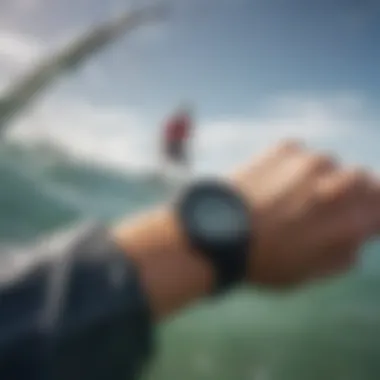
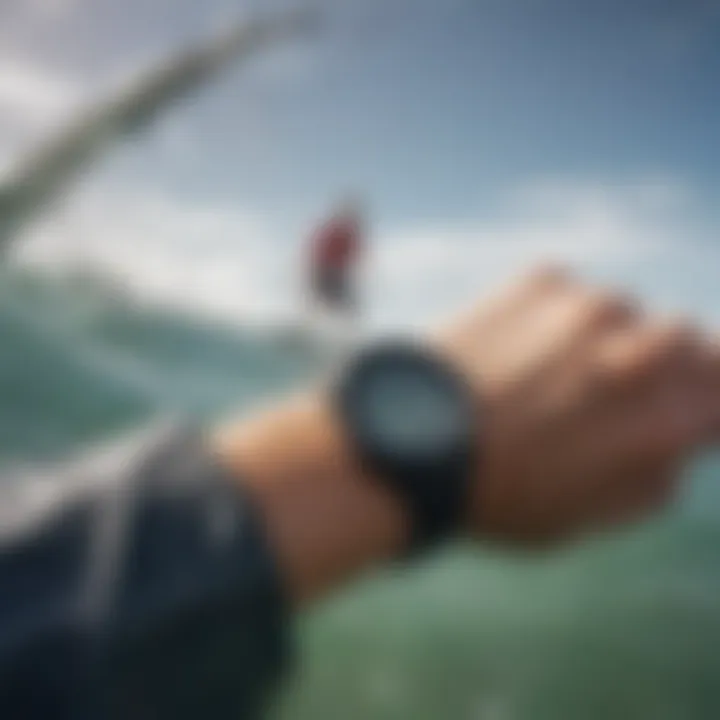
By assessing what you genuinely need from the watch, you set the foundation for a satisfactory purchase.
Budget Considerations
Talking money is never fun, but it’s a vital part of the decision-making process. Garmin watches come in a range of prices, so knowing your budget will help narrow down options efficiently. Here are some details to mull over:
- Entry-Level Models: If you’re just dipping your toes into both surfing and tech, there are models that don’t break the bank but still offer essential features like basic tracking and weather alerts. These are ideal for surfers looking to get acquainted with data tracking without investing too heavily upfront.
- Mid-Range Options: For those who have spent a bit more time in the water and want to dive deeper into metrics, mid-range Garmin watches can offer a balance of functionality and cost. These often include improved tracking capabilities and better displays, catering to the average surfer’s curiosity about their performance.
- High-End Choices: If surfing is your primary passion and you require high-level data for performance analysis, investing in a premium model might be worth every penny. These models offer precise GPS, customizable apps, and advanced health tracking features designed for real athletic performance.
Remember, it’s not just about the watch’s price tag; it’s about the features you’ll use frequently. The goal is to invest smartly and not stretch your wallet unnecessarily; think of it as choosing between a reliable friend and a luxury item.
Investing in the right Garmin model can significantly impact how you engage with the surf, making your sessions more productive and enjoyable.
Balancing your needs with a suitable budget will ultimately guide you towards making an informed purchase, ensuring your time on the waves is as thrilling as possible.
Maintenance and Care for Your Garmin Watch
Taking care of your Garmin watch is not just about appearances; it plays a critical role in ensuring its longevity and performance. Just think about this—the ocean is as much a friend as it is a foe. It brings the waves that we ride, but salt and sand can be harsh on your gear. Regular maintenance safeguards your investment, enhances function, and ensures that all the bells and whistles work seamlessly when you catch that perfect wave. It’s about finding the right balance between enjoying your time in the water and keeping tabs on your tech.
Cleaning and Upkeep
When it comes to cleaning your Garmin watch after a surf session, keep in mind that simplicity works wonders. Rinse it under fresh water to remove salt and sand that accumulates during your ride; this is step one. A soft cloth also does wonders—think of it as a gentle hug for your watch. It helps wipe away any stubborn grime without harming the screen.
- Avoid Harsh Chemicals: Just like you wouldn’t want to drown a plant with chemicals, avoid using anything too abrasive or aggressive. Stick to mild soap if needed.
- Maintain the Band: If the watch has a silicone or fabric band, give it occasional washes too. It might seem minor, but keeping the straps clean can prevent skin irritations.
- Drying Techniques: After rinsing, don’t just throw it down on a towel. Let it air dry properly; moisture trapped can lead to potential tech troubles.
By making cleaning part of your routine, you not only enhance the lifespan of your device but also ensure that you’re monitoring your performance accurately on subsequent outings.
Software Updates and Features
Technology doesn’t sit still, and Garmin's features expand and improve over time. Keeping your watch’s software up to date is like having a personal trainer who knows the latest tricks to boost your performance. Regular updates can fix bugs, enhance functionalities, and even roll out new features that could improve both the tracking and analysis of your surfs.
- Update Frequency: Check for updates at least once a month or so. It’s similar to checking the weather before hitting the waves—you wouldn’t want to be caught off guard.
- How to Update: Connect your watch to a smartphone or computer that has the Garmin Connect application. It's usually a straightforward process; follow the prompts, and you’re good to go.
- New Features: Updates may include improved algorithms for tracking waves or even expanded features for performance metrics. These can provide you with deeper insights into your surfing habits.
Keeping your Garmin watch updated is essential for getting the most out of all the high-tech capabilities it offers. With each update, you're making a choice for better accuracy and a more enriched surfing experience.
Regular maintenance doesn’t just extend the life of your Garmin watch; it ensures you’re ready to seize every wave with confidence.
Future Trends in Surf Technology
As technology seeps deeper into our daily lives, the realm of surfing is not left untouched. The importance of examining future trends in surf technology, especially in relation to devices like Garmin watches, cannot be overstated. These advancements aim to enhance user experiences while also addressing safety considerations and performance metrics crucial for both novice and seasoned surfers alike. This section delves into innovations on the horizon and highlights technology's pivotal role in ensuring surf safety.
Innovations on the Horizon
The upcoming innovations in surf technology are poised to redefine how surfers interact with the waves and their environment. Some noteworthy advancements include:
- Smart Wetsuits: These suits will integrate sensors that provide real-time feedback on body temperature, heart rate, and surf performance. Imagine riding a wave while your suit keeps you informed about your physioloical conditions without needing to check your watch. Isn't that something?
- Enhanced Wearable Technology: Future Garmin models may incorporate more advanced sensors that not only track wave height and frequency but can also analyze complex algorithms to give tailored feedback to surfers about their ride efficiency. The potential to optimize each session could be a game-changer for surfers who chase perfection.
- Augmented Reality (AR) Integration: Some new devices may utilize AR technology to overlay pertinent information on the ocean itself, helping surfers read the waves better while out in the water. Picture a scenario where, with just a flick of the wrist, you could see the ideal swell approaching before it hits you.
- AI-Powered Coaching: Imagine having a virtual coach that analyzes your every move on the wave, offering corrections in real-time or after your session. This could advance a surfer's skill level quickly and efficiently.
These innovations promise to make surfing not only more enjoyable but also safer, providing surfers with better tools to read conditions and understand their performance.
The Role of Technology in Surf Safety
Tech isn't just for tracking your wave count; it's about keeping you safe too. The waters can sometimes feel unpredictable, and having tech that keeps you informed can make a world of difference. Here's how future trends stress safety in surfing:
- Emergency Notifications: Upcoming features could automatically send distress signals if a surfer finds themselves in a precarious situation, such as being swept away or struggling to return to shore.
- Wave and Weather Alerts: Improved connections to satellite data may offer real-time updates regarding weather changes, thus alerting surfers to potential hazards before they become life-threatening. With a simple glance at your Garmin, you could avoid dangerous situations posed by sudden storms.
- Training Safety Metrics: Through technology, surfers can monitor their health metrics more meticulously, avoiding overstress on their bodies and reducing injury risks during challenging surf conditions. Having this data available means you can better gauge when to push through the limits and when to play it safe.
End
The conclusion serves as a vital segment of this article, emphasizing the relevance of the Garmin watch in the realm of surfing. Not only does it encapsulate the extensive functionalities explored throughout the article, but it also reinforces the benefits that surfers can derive from integrating technology into their adventurous pursuits. This reflection on the Garmin watch highlights the various ways it can elevate a surfer's experience, whether they're mesmerizing onlookers with their skills or simply enjoying the thrill of the waves.
With the right Garmin model, surfers can harness advanced tracking capacities and receive real-time weather updates, ensuring they're always prepared. The performance metrics provided by the watch enable them to assess their physical state and refine their techniques in a more informed manner.
Additionally, the statistical insights and user feedback illustrated earlier indicate a strong consensus among surfers about the watch's utility and reliability. As outdoor enthusiasts dive into the depths of their surfing expeditions, the Garmin watch stands as an indispensable companion, ensuring they ride the waves confidently.
Summarizing the Benefits
In wrapping up the key benefits of the Garmin watch for surfers, a few significant aspects come to the fore:
- Precision Tracking: GPS tracking capabilities guarantee accurate wave counts and distance surged, giving surfers detailed insights into their performance.
- Weather Intelligence: Access to tide information, wind speeds, and wave heights secures better planning and safer surfing experiences.
- Performance Analysis: Features such as heart rate monitoring and VO2 max estimation help surfers understand their condition and recovery needs, facilitating improved training regimens.
- User Integration: The ability to integrate with popular surf community apps fosters a sense of camaraderie among surfers, enabling them to share insights and challenges.
This comprehensive overview showcases the multifaceted advantages that come with using a Garmin watch, making it an essential tool for any serious surfer.
Looking Ahead
As technology continues to evolve, the future holds exciting possibilities for the integration of devices like the Garmin watch in surfing. Innovations on the horizon could introduce features that enhance safety, efficiency, and even the environmental impact of surfing.
As we look forward, it’s likely that manufacturers will prioritize seamless connectivity, allowing surfers to customize their experiences further. For instance, the addition of AI-driven predictive algorithms could help them analyze patterns in wave behavior or personal performance.
Furthermore, the blend of technology and environmental consciousness is becoming more prominent. Future devices might incorporate features to monitor ocean health, promoting sustainable practices among the surfing community.















